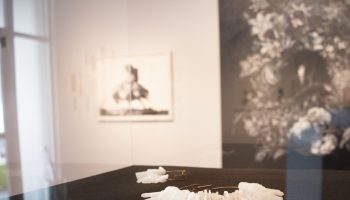Before getting into the 60th Chautauqua Annual Exhibition of Contemporary Art, it’s worth noting that the very first Annual took place during a year — 1957 — that marked a high tide of sorts for postwar American art. New York was the world’s undisputed art capital, a title wrested from Paris after World War II. The dominant style was Abstract Expressionism, which was dominated in turn by white heterosexual male artists who drank heavily and sometimes got into physical brawls over aesthetic arguments. It was, in short, a simpler era, if one necessarily limited by prejudice and privilege.
All of that would change over the next six decades with the emergence of new movements (Pop Art, Minimalism, Conceptual Art) new mediums (video, installation, performance) and new demands to admit women, people of color and members of the LBGTQ community to the art world. Ironically, this onrush of change represented the beginning of an unraveling that eventually led to the decentralized, global art world of today, where art is distributed through international fairs that value money over ideas. But it’s also an art world defined by a multiplicity of sensibilities unbound by rules — a diversity reflected, in its own way, in this milestone edition of the Annual. Organized by Don Kimes, Lois Jubeck and Judy Barie, the exhibition features 60 works, one for each year of the show’s existence, by more than 50 artists from all over the country.
An energetic affair enlivened by attention-grabbing work, the show seems to favor painting, although sculpture plays a noticeable role. In fact, the winner of the top prize, the Bellinger Award, is “Squirrel Whisperer,” a life-size assemblage of bronze, wood and cast-iron by Bill Kofmehl. It pictures an ordinarily serene interlude of city living — sitting on a park bench — as something dark and deranged, as a man working on a laptop (a self-portrait) is beset by a marauding gang of squirrels, including one perched atop his head like it owns the place. Though Kofmehl is from Pittsburgh, “Squirrel Whisperer” is rooted in the story of Bernard Goetz, the so-called “Subway Vigilante” who became synonymous with the crime-ridden New York City of the 1980s. Accosted on the train by a group of African-American youths in 1984, Goetz shot four of them, putting one in a wheelchair for life. Goetz was eventually acquitted of assault and illegal weapons charges, becoming a symbol of the racially tinged backlash against the perceived social chaos of the period. Later in life, he became known for feeding squirrels near his home and keeping them as pets (for which he was threatened with eviction). Kofmehl became personally acquainted with him and includes a cast of Goetz’s hand in a piece that surreally memorializes the two most notable aspects of his life.
The winners of the Annual’s other major prizes aren’t as concerned with recent history, but their contributions are compelling all the same. New Jersey photographer Aubrey Kauffman, recipient of the runner-up VACI Partner award, presents “Blank Wall,” an image of a highway on-ramp embankment resolving into a nourish abstraction thanks to the taut triangular lines of a shadow cutting across its lower right corner. Bill Hill’s radiant “Say John Show Us,” winner of the Debra Anderson Award for second runner-up, is an oil composition built out of lyrical veils of blues and oranges that evoke a sunset infused with wonder.
“Evening Abandon” by Rachel Rickert, winner of the James O’Brien Award, offers a humidly erotic depiction of what at first appears to be three women sharing a shower stall. Two of them on the left are completely naked, though their heads are cut off by the top of the frame; one woman seems to be hanging a pair of yoga pants up to dry, its legs rendered as two large slashes of black forming an inverted “V” near the painting’s center. A third figure on the right is turned away from the viewer, pulling tights down to her thighs. A closer inspection of the image suggests that it’s the same person in different stages of undress. Whatever the case, the languor of the scene contrasts with Rickert’s broad, choppy brushstrokes, while the poses of the trio evoke the Old-Master theme of the Judgement of Paris.
Classicism gives way to alienation in the pairing of a pastel by Paul Nugent and a photograph by Charles Mintz. Nugent’s “Passer By” is an exercise in brooding realism that presents the head of a bald man in profile, his features submerged in a subterranean murk of black, grey and white. All you can really make out is his rather meaty ear and the light-dappled contour of his pate. Mintz’s “Cedar Center Hardware,” meanwhile, opens onto the interior of the eponymous store, empty except for a dense profusion of wares that includes cans of spray paint, tubs of spackling compound, paintbrushes, keys dangling from a display and an overhead frieze of vintage license plates hung from the ceiling. The colors of each item have been punched up with Photoshop, imparting a sheen that is at once laser sharp and detached from reality. In condensed, Main Street fashion, Mintz manages to evoke the same inexorable flow of consumerism found in the panoramic shots of supermarkets and Amazon fulfillment houses by the German photographer Andreas Gursky.
Consciously or not, the presence of other artists find their way into many of the works here. Bruce McCombs’ exacting watercolor, ink and acrylic rendering of the entrance to The New York Times building is basically an homage to photorealist painter Richard Estes, while Tracy Hoffman’s photomontage, “Leaning in with Bridget Riley,” makes explicit her admiration for the doyenne of 1960s Op Art, one of the few widely known female artists of her generation. Elsewhere, Bonnie Ashmore’s looping abstract forms have whiffs of Sonia Delaunay and Georgia O’Keeffe about them, while Jesse Howard’s impressively grave charcoal portrait, “Observer with Spex,” finds a common ground between the attenuated figuration of Albert Giacometti, the tight cropping of Chuck Close and Expressionistic distortions of Francis Bacon. Parts of Mia Tarducci color-saturated abstraction recall the squeegee paintings of another German artist, Gerhard Richter.
A couple of the works here could be called sui generis, or a least idiosyncratic in the ways they evoke a kind of sci-fi futurism. James Campbell’s mixed-media encomium to social media, “Snapchataxia,” is a wall relief that resembles a comm-badge from “Star Trek.” Its skein of driplike marks were created by an elaborate offset process similar to the one used to make monoprints. Alison Helm also has a relief on view, an agglomeration of cast-resin prismatic nodules lit from behind like a prop from an alien abduction movie.
Juried exhibitions are something like pot-luck dinners, and the menu of artists for this year’s show is the largest ever, making it hard to mention every participant. They all make the 60th Chautauqua Annual Exhibition a special occasion, however, giving it an infectious spirit that will hopefully carry on for another 60 years.
Howard Halle is editor-at-large and chief art critic for Time Out New York.





